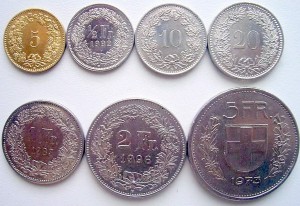I’ve noticed another sign of my integration into Swiss culture. I call it “money math.” To explain what I mean, first you have to understand the smallest denominations of Swiss currency. Joe covered Swiss Franc bills in a previous series, but he stopped before he got to the most common form of money that we deal with every day — the coins.

In Switzerland, the smallest paper currency is 10 Francs. So, the coins, from largest to smallest are: 5 Francs, 2 Francs, 1 Franc, 50 cents, 20 cents, 10 cents, and 5 cents. (“Cents” are actually called “Rappen” here, but I don’t want to confuse the issue.) This is so completely different than the breakdown of coins in the US. For starters, you will notice there is no penny. The 1-cent coin was taken out of circulation in 2006. (There was also a 2-cent coin that was taken out of circulation in 1974.) You can still come across these coins occasionally. They are actually considered to be good luck. But, officially, there is nothing smaller than 5-cents, so all prices end in 5s or usually 10s. There are no prices ending in $.99. Imagine that!
Secondly, the value of coins is so much greater. A 5 Franc coin is worth $5.44 today. A small collection of coins in my purse could easily be worth over $20. Which leads me back to money math. When you grow up counting quarters, dimes, nickels and pennies, it is really hard to switch gears. For example, if something costs 22.75 in the US, that would be a $20 bill, two $1 bills, and 3 quarters. In Switzerland, it’s a 20 CHF bill, a 2 CHF coin, a 50-cent coin, a 20-cent coin, and a 5-cent coin.
When we first got here, my brain just couldn’t do the math fast enough at the checkout counter, especially since I wasn’t familiar enough with the coins to know what each one was worth without flipping them around to look at the numbers. Plus, I was trying to just understand what the clerk was asking me in Swiss German. (Her: “Do you have a store savings card?” Me: “What?” Her: “Would you like your frozen items in a plastic bag?” Me: “What?” Her: “That will be 87.90 please.”) At this point, I would just look at the display screen to decipher the number she had just said, hand her whatever bill I had that was bigger, accept whatever change she gave me and get out of there as quickly as I could. This resulted in an extremely large collection of coins in my purse, until finally I decided I had to start using them.
It was a long and slow process. But the other day I realized that I hardly ever say “What?” at checkout counters anymore, and I can count out my change like a pro. In fact, it was harder for me to think about the US breakdown in my earlier example than the Swiss breakdown! I’ve grown to really like the larger coins here. In fact, when we come back to the US, I think I might do my part to help the US economy by using all those $1 coins that the US made that are sitting in storage because no one wants to use them. But, that’s a different issue.

You picked the right day to talk about money. Super Bowl Sunday!! There is always gab about ticket prices, costs of hotel rooms, financial benefit to the host city, the players take, etc, etc. Then, of course, the cost of a one minute add on TV-I heard it is $8 mil. You can pay for one by emptying your purse of those 5 Frank coins. YLF, YLFIL, YLG